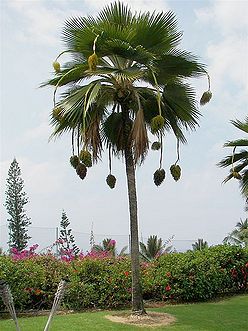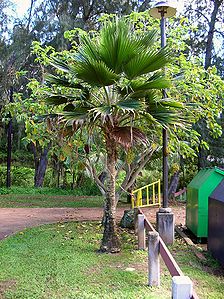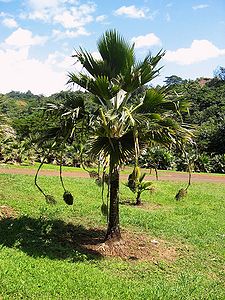Difference between revisions of "Pritchardia thurstonii"
| Line 118: | Line 118: | ||
image:Post-90-1195159902.jpg|Hawaii. Photo by Al in Kona, edric. | image:Post-90-1195159902.jpg|Hawaii. Photo by Al in Kona, edric. | ||
image:Post-90-1205302739.jpg|Hawaii. Photo by Al in Kona, edric. | image:Post-90-1205302739.jpg|Hawaii. Photo by Al in Kona, edric. | ||
| − | image:|Parrish, FL. Photo by Bill, edric. | + | image:PtIMG_1321Large.jpg|Parrish, FL. Photo by Bill, edric. |
| − | image: | + | image:PtIMG_1320Large.jpg|Parrish, FL. Photo by Bill, edric. |
| − | image: | + | image:PtIMG_1617Large.jpg|Parrish, FL. Photo by Bill, edric. |
image: | image: | ||
image: | image: | ||
Revision as of 09:22, 20 February 2014
<google>CH02</google>
| Pritchardia (pritch-AHR-dee-uh) thurstonii (thurs-ton'-ee-eye) | |||||||
|---|---|---|---|---|---|---|---|
 Hawaii. Photo by Al in Kona, edric. | |||||||
| Scientific Classification | |||||||
| |||||||
| Synonyms | |||||||
|
| |||||||
| Native Continent | |||||||
|
| |||||||
| Morphology | |||||||
| |||||||
| Culture | |||||||
|
| |||||||
| Survivability index | |||||||
|
| |||||||
| Common names | |||||||
|
| |||||||
Contents
Habitat and Distribution
Fiji, Tonga. Moist to wet forest on rough, sharp, folded, pitted, fissured karst limestone, slopes, cliffs, large boulders and small islands, Fiji (Lau Group: Vanuabalavu, Vulaga, and Ogea Drikj) and Tonga (Eua), 0-200 m elev. (Hodel, D. 2007)/Palmweb.
This palm comes from the Lau Group in eastern Fiji. In habitat it grows in Limestone soils.
Desciption
To 8 m tall, erect, rarely distinctly serpentine or saxophone-shaped; proximal margins of petiole with only a few fibers; leaf blade flat, divided 1/5-1/4, slightly waxy-glaucous, abaxial leaf blade surface with lepidia conspicuously arranged in distinct, parallel lines, segment tips stiff; inflorescences composed of 1 panicle, equaling or exceeding leaf blades in flower to greatly exceeding leaf blades in fruit, panicles branched to 2-3 orders, rachillae glabrous; fruits 7 mm in diam., globose. (Hodel, D. 2007)/Palmweb. Editing by edric.
The lepidia on the abaxial leaf blade surface, conspicuously arranged in distinct, parallel lines, are diagnostic for Pritchardia thurstonii. It is rather widely cultivated in tropical gardens. On Vulaga and Ogea Driki in the Lau Group of Fiji, Pritchardia thurstonii is restricted, in rather spectacular fashion, to the tops of small, mushroom-shaped, karst limestone islets in their lagoons, nearly to the exclusion of all other woody vegetation (Fuller 1997, Fuller & Jones 1999, Watling 2005). On Eua island in Tonga, it is confined to the rock escarpment 200-300 m high on the southeast coast. There it occurs from the lip or crest near the top of the escarpment, sometimes with serpentine trunks, down to the sea coast. At the base of the escarpment, near and at the sea, is a jumble of gigantic, limestone boulders, some as much as 10-15 m in diameter, amongst and on top of which grow P. thurstonii. There is no barrier reef at this point, and waves crashing on the rocks at times envelope the surrounding area, including the palms, in a salt-laden haze. Because Mueller and Drude did not designate a holotype from the original material, Moore selected a lectotype at MEL and an isolectotype at Kas the type material for this species (Moore 1979). Several workers (Lister 1893, Burkill 1901, Beccari & Rock 1921, Watling 2005) have erroneously referred to Tongan material of Pritchardia thurstonii as P. pacifica. likewise, herbarium specimens of P. thurstonii from Tonga are frequently misidentified as P. pacifica. (Hodel, D. 2007)/Palmweb.
Pritchardia thurstonii grows to 6.7 m tall bearing fronds that are up to 1.5 m in length. As with all Pritchardia leaves the blades are plicate meaning that they are folded like a fan and this species has up to 70 folds across the leaf surface. The leaves are split along the fold from the tip of the leaves partway to the base. A layer of wax covers the leaf surface, which may help prevent water loss during exposure to the high winds, and salt in the coastal environment in which it is found. The flowers are borne in clusters on a long stalk up to 1.8m long that arches down below the foliage. The mature fruit are each only about 0.5 cm in diameter but each inflorescence bears many fruit that form a large mass of deep red-purple fruit as they ripen. (Staples, G. W. and D. R. Herbst. 2005.), edric.
The thurstonii is a solitary palm and has palmate circular leaves. It's inflorescences extend out beyond the crown and hang down giving an elegant appearance.
Stem Solitary, upright stems to 8 m tall and up to 20 cm in diameter, often spreading slightly at the base, brown or dark gray in color, with vertical fissures and narrow rings of leaf scars. Leaves: Costapalmate, induplicate, 2-3 m across, undulate, forming a semi-circle, divided into stiff, single-fold segments usually no more than one-half the length of the leaf blade, with erect, bifid leaf segment tips. The leaf color is bright green with a thin waxy coating. The undersurface of the blade is marked by whitish scales in parallel lines, and the petiole and abaxial midribs are covered with gray or whitish wooly tomentum. The leaf sheath breaks down into a mass of tawny fibers. The petiole is smooth and unarmed. Flowers and fruit: Inflorescences to 2 m long with single panicles of yellow flowers, branched to two or three orders, extending well below the leaf canopy when in fruit. Fruits spherical, red, and 64 mm in diameter. (lucidcentral.org), edric.
Culture
In culture the P. thurstonii likes full sun, and moist soil. Wind and salt tolerant. It's hardiness is USDA Zone 10b - at around 35°F or 1.7°c.
Lau Fan Palm is considered a host for a plant disease called Lethal Yellowing that is found in the Florida, Puerto Rico, and Guam. Lethal Yellowing is a disease that causes Coconut palms to drop their undeveloped and developed fruit, causes new inflorescences to turn black, and the fronds to turn yellow. Lethal Yellowing is thought to be caused by organisms called mycoplasmas that are transmitted by the planthopper, Myndus crudus. As a result of this Louisiana, Texas, and Mississippi restrict the transport of Lau Fan Palm from regions where Lethal Yellowing has been reported. Fortunately the planthopper that transmits this disease does not yet occur in Hawai‘i. (Chapin, M.H., K.R. Wood, S.P. Perlman, and M. Maunder. 2004.)
Comments and Curiosities
Etymology: Pritchardia name is dedicated to William Thomas Pritchard (1829-1907), British official stationed in Fiji in the 19th Century, British counsul in Fiji, adventurer, and author of Polynesian Reminiscences in 1866. The epithet (species name) is named after Sir John Thurston, who became Governor of Fiji in 1887. edric.
"Pritchardia thurstonii is endemic to Fiji "Lau Group," and Tonga (ʻEua Vavaʻu)." (Encyclopedia of Life curator Dr. David Eickhoff), edric.
"This palm is hard for me to distinguish from Pritchardia pacifica, also from Fiji, as it has similarly large, flat, finely pleated stiff leaves of incredible beauty... supposedly used frequently as avenue plant in Hawaii (wouldn't know which are which, though). Also similarly tolerant of salt water. The primary differences, that have been pointed out to me, are 1) this palm's flowers extend far beyond the leaves and look like ornaments hanging down from the crowns... while flowers of P. pacifica are still nestled within the leaves... and 2) this palm is a bit smaller in leaf size, and a tad less 'perfect' in the size/shape of the leaf." (Geoff Stein), edric.
Similar to Pritchardia pacifica, this species grows on coralline limestone on the tiny islands of Fiji's Lau group in the Southwest Pacific. It is one of the most attractive, robust, and easily grown fan palms for tropical climates. (RPS.com), edric.
External Links
- Glossary of Palm Terms
- MODERN BOTANICAL LATIN
- "Just To Be Clear"
- http://myloulu.wordpress.com/2010/09/13/the-island-of-oahu/
- http://myloulu.wordpress.com/2010/09/08/the-island-of-maui/
- http://myloulu.wordpress.com/2010/09/27/the-islands-of-niihau-and-nihoa/
- http://myloulu.wordpress.com/2010/09/06/the-island-of-hawaii/
- http://myloulu.wordpress.com/2010/09/21/the-island-of-kauai/
- http://myloulu.wordpress.com/2010/09/08/the-island-of-lanai/
- http://myloulu.wordpress.com/2010/09/08/island-of-molokai/
- http://hanapalms.wordpress.com/2010/07/
- http://www.biomedcentral.com/1471-2148/12/23
References
Phonetic spelling of Latin names by edric.
Special thanks to Geoff Stein, (Palmbob) for his hundreds of photos, edric.
Special thanks to Palmweb.org, Dr. John Dransfield, Dr. Bill Baker & team, for their volumes of information and photos, edric.
Glossary of Palm Terms; Based on the glossary in Dransfield, J., N.W. Uhl, C.B. Asmussen-Lange, W.J. Baker, M.M. Harley & C.E. Lewis. 2008. Genera Palmarum - Evolution and Classification of the Palms. Royal Botanic Gardens, Kew. All images copyright of the artists and photographers (see images for credits).
Hodel, D. 2007.
- IMAGE GALLERY
Many Special Thanks to Ed Vaile for his long hours of tireless editing and numerous contributions.
















































